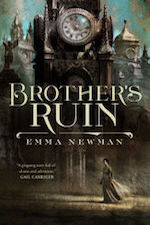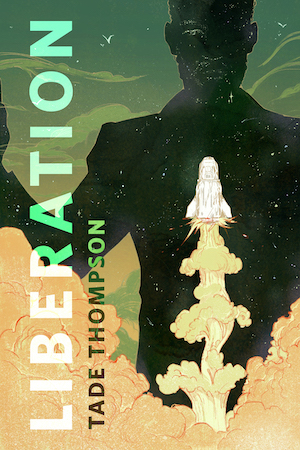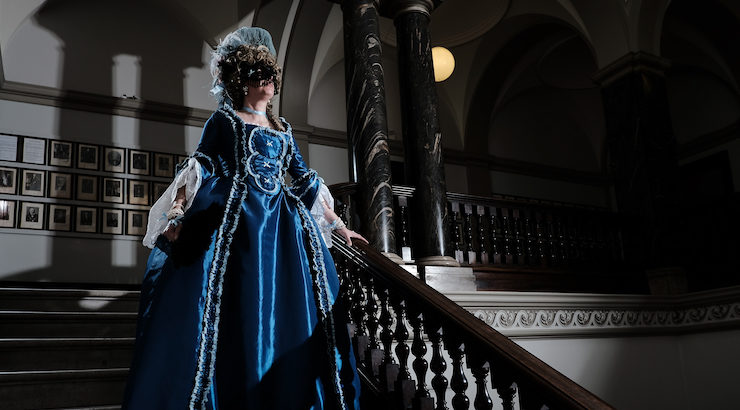In this ongoing series, we ask SF/F authors to describe a specialty in their lives that has nothing (or very little) to do with writing. Join us as we discover what draws authors to their various hobbies, how they fit into their daily lives, and how and they inform the author’s literary identity!
I spend a lot of my time in fictional worlds. Some are of my making, and the time I spend there is usually filled with writing, plot wrangling and research. However, there are other worlds, not of my making, that I have had the pleasure of visiting via my main hobby: LARP.
LARP stands for Live Action Role Playing and it’s a broad term encompassing a wide variety of experiences. The ones I enjoy are either played by huge numbers of players over long weekends, usually outside (“Fest” LARPS), or held indoors with fewer players and more structure. They all have several key common features: I make costumes and wear them as my character, I participate in a shared world with other players and as much as possible I stay in character for the duration of the game. This means that I move, talk, and act like my character, rather than like myself. It means I do all I can to maintain the common suspension of disbelief for the benefit of my fellow players and it means that I may make decisions and take actions that I would not in real life.
LARP can be much harder to get into if you don’t know someone who is already doing it. I was very lucky to almost literally stumble into it thanks to spotting a Star Trek shop in a town I was visiting. I was about 15 at the time and utterly obsessed with Star Trek: The Next Generation. This was back in the 90s, before the internet was of any real use to anyone outside of universities, and when fandom was much harder to access. Walking into that shop was like entering a cave full of treasure. Meeting the owners and the people hanging out there was like meeting my tribe after living in exile. And when they opened the back door of the shop and showed me a pretty damn good replica of the Enterprise (NCC -1701-D) bridge, I thought I had discovered heaven. Then they told me that every week a bunch of them got together to do ST:TNG LARP and that I was welcome to join in if I wanted.
Bemused, my Mum and aunt diligently sewed me my first costume. I made up a character and jumped right in with both feet, feeling like it was the most natural thing in the world. I was hooked.
Spool forward a few years and I arrived at university. At the Fresher’s Fair, there was only one society I was looking for: RPGSoc. My university life was dominated by both table top games and LARP. It still being the nineties, we were all into White Wolf games in a big way. I played a string of vampires in both table top and LARP, swanning about an ancient university in full costume on many occasions. I made my dearest lifelong friends there and lived several lifetimes with them. I played and I was a GM (games master). I got obsessed and I also learned all about stories; their shape, their value, and their power. I learned about narrative arcs by playing through them and designing them for others. I learned about world building through the creation of worlds and how to ease people into them when my friends played in them.
And those lessons have never left me. So many of the skills I have as an author were honed in roleplaying and GMing. Instincts about the way to draw a reader into a new world were acquired when drawing players into a new game world. The tension between having a clear idea of a narrative arc in terms of the plot and the desires of realistic characters that may pull in another direction was experienced at the gaming table long before I wrote my first book. And, of course, the first book—indeed trilogy—I ever wrote was based on a game I had GMed! So was the Split Worlds series, come to think of it, which first existed as a game I ran for my husband. It evolved and changed a lot between game and publication, but its roots were there. Then a few years later, between the publication of the 3rd and 4th books in the series, the world was revisited as a game again. Myself and the inestimable Katie Logan (whose Tumblr Ladies Who LARP is a joyful thing) ran a Split Worlds Masked Ball LARP with over 80 players in which characters from the books (and some newly created for the LARP) played through an evening in the world that exists in canon. It was one of the most intense, terrifying, and wonderful things I’ve ever done.
So many of the friends I’ve made in the author community are role players too. It’s even come full circle; one of my favourite authors and professional peers, Adrian Tchaikovsky went on to also become my GM (D&D 5th ed, I love it so much) and now we are playing in a new D&D game together being run by my husband. Who I met whilst, you guessed it, roleplaying!
I cannot imagine my life without this hobby. It has shaped me, given me experiences that I never would have had and enabled me to explore worlds, characters and dilemmas that I never would have had the chance to explore otherwise.
So if you have a friend who LARPs or plays in table top games and has invited you along, try it! You never know what you might get out of it.
Top image: photo of Emma Newman by Tom Garnett. “Here I am playing the Censor of Aquae Sulis from my Split Worlds series at the Masked Ball LARP. That costume was hard work to make!”
Emma Newman writes science fiction and urban fantasy novels, along with gaslamp fantasy novellas. She won the British Fantasy Society Best Short Story Award 2015 and Between Two Thorns, the first book in Emma’s Split Worlds urban fantasy series, was shortlisted for the BFS Best Novel and Best Newcomer 2014 awards. Her science-fiction novels, Planetfall and After Atlas, are published by Roc, and her novella Brother’s Ruin is available from Tor.com Publishing. Emma is an audiobook narrator and also co-writes and hosts the Hugo-nominated, Alfie Award winning podcast ‘Tea and Jeopardy’ which involves tea, cake, mild peril and singing chickens. Her hobbies include dressmaking and playing RPGs. She can be found as @emapocalyptic on Twitter.
writes science fiction and urban fantasy novels, along with gaslamp fantasy novellas. She won the British Fantasy Society Best Short Story Award 2015 and Between Two Thorns, the first book in Emma’s Split Worlds urban fantasy series, was shortlisted for the BFS Best Novel and Best Newcomer 2014 awards. Her science-fiction novels, Planetfall and After Atlas, are published by Roc, and her novella Brother’s Ruin is available from Tor.com Publishing. Emma is an audiobook narrator and also co-writes and hosts the Hugo-nominated, Alfie Award winning podcast ‘Tea and Jeopardy’ which involves tea, cake, mild peril and singing chickens. Her hobbies include dressmaking and playing RPGs. She can be found as @emapocalyptic on Twitter.











Oh I love table top gaming playing D&D, Shadowrun, Rifts, I’ve never tried white wolf games because my groups didn’t play those for whatever reason. I played from 5th grade through grad school but need to hunt down a new group these days. I couldn’t get into LARPing. I can’t suspend my disbelief long enough to get into it, maybe it was because I went to an SCA weekend in the park instead of Star Trek. It also could of been because there are no dragons or griffins to play with me. I don’t mind conventions. I’m going to try cosplay at Dragon-con this summer. Your book is on my library hold list and I can’t wait for my turn.
Oh my – the memories.
D&D with friends all during Highschool.
College I spent more time than I should have as a Toreador Vampire with more Occult knowledge than most of the Tremere around my area.
Then grad school and almost a decade in the SCA. Because, while many SCAers don’t like to think of it as a LARP – it is. Just lest role playing for most.
It shapes us indeed. It shapes stories and storytelling.
Thank you for sharing.
I’m a tabletop roleplayer, and only LARPed once, it never really caught my fancy… but all roleplayers are my brothers and sisters, so I loved reading about this. I would have, however, loved to find that TNG LARP back in the day and join…
I do much more table-top than LARP (especially lately). But I do enjoy LARPing, particularly with the inclusion of romance rules that add much to the game that rarely seems to be included in table-top. Sure, inter-character relationships occur in table-top, but not quite to the levels of tragic melodrama that LARPs inspire.
I never LARPed (the costuming aspect is a bit intimidating to me) but I D&Dd through college, and a friend and I both transcribed our sessions and wrote stories from the point of view of our characters. It was fun :)
Do you know about Intercon, a four-day long all LARP convention, now in Warwick, RI? Intercon T just ran at the end of February 2020. We’re already hard at work on Intercon U (https://u.interconlarp.org), our 24th Intercon. Intercon T had 468 attendees, playing in their choices from more than 110 different LARPs. That doesn’t cover workshops, panels, and other LARP-related events. Five teams took part in the Iron GM contest, where they wrote a new LARP in 24 hours, based on a set of ingredients they got at the start of that time period. This is the first year in a very long time when I didn’t run one of my LARPs, which meant that I could play in 8 different LARPs.